Volkswagen Group: Operations, Logistics, Supply Chain Analysis
VerifiedAdded on 2020/07/22
|12
|3360
|59
Report
AI Summary
This report provides a comprehensive analysis of Volkswagen Group's operations, logistics, and supply chain management. It begins with an introduction to logistics and its importance in supply chain management, specifically within the context of the Volkswagen Group, a global automotive manufacturer. The main body of the report explores key operational strategies, including the 'Together Strategy 2025,' and the group's approach to digitalization, autonomous driving, and battery technology. It then delves into the company's logistics operations, highlighting the role of exports, supplier networks, and the challenges posed by technological, social, and economic changes. The report also examines supply chain management issues, such as sustainability, supplier relations, and risk management. Furthermore, it analyzes Volkswagen's new product development process, including idea generation, screening, concept development, market strategy, business analysis, test marketing, and commercialization. Finally, the report discusses the management of quality within the organization, and concludes with recommendations for improvement and further development. The report is a valuable resource for understanding the complexities and strategies within the automotive industry's operations and supply chain.
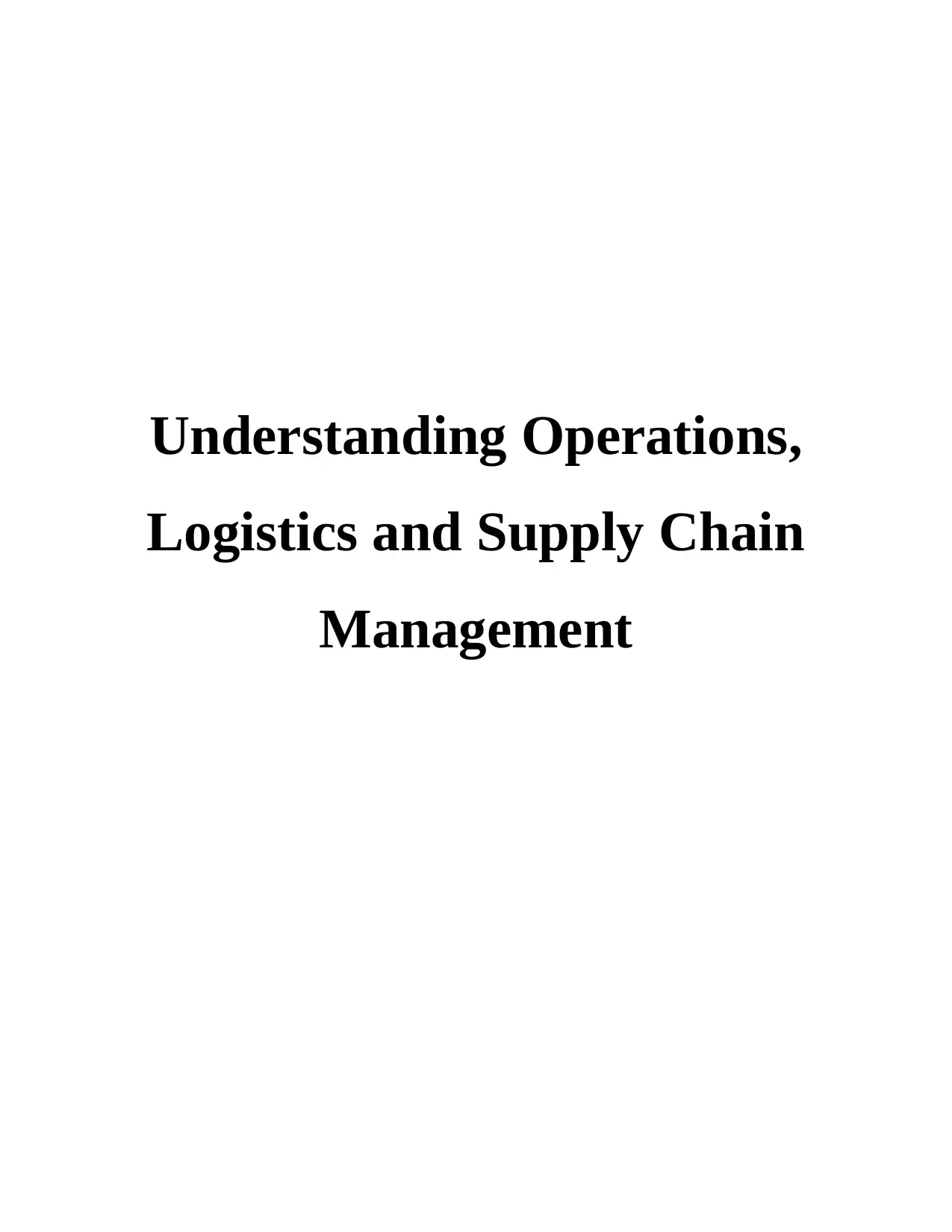
Understanding Operations,
Logistics and Supply Chain
Management
Logistics and Supply Chain
Management
Paraphrase This Document
Need a fresh take? Get an instant paraphrase of this document with our AI Paraphraser
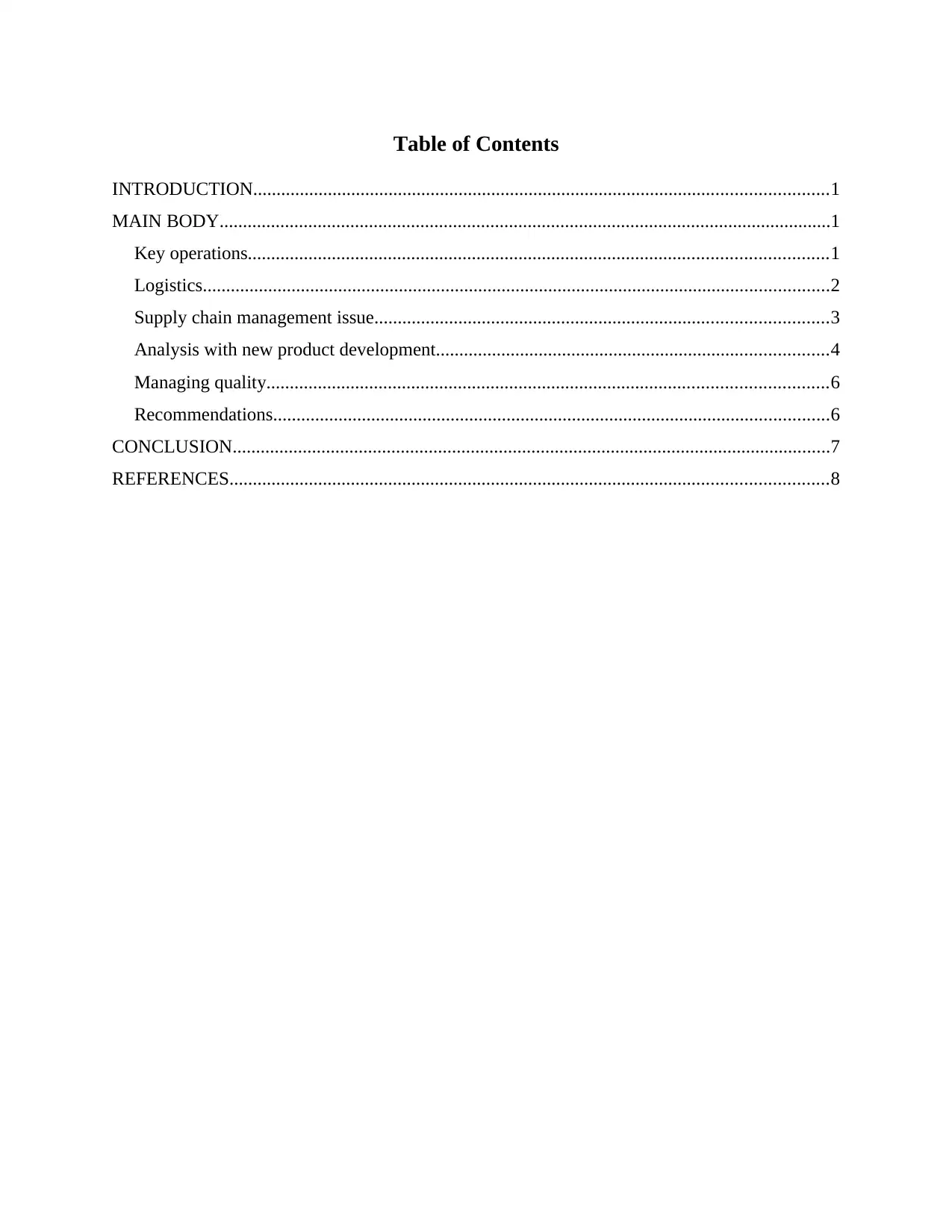
Table of Contents
INTRODUCTION...........................................................................................................................1
MAIN BODY...................................................................................................................................1
Key operations............................................................................................................................1
Logistics......................................................................................................................................2
Supply chain management issue.................................................................................................3
Analysis with new product development....................................................................................4
Managing quality........................................................................................................................6
Recommendations.......................................................................................................................6
CONCLUSION................................................................................................................................7
REFERENCES................................................................................................................................8
INTRODUCTION...........................................................................................................................1
MAIN BODY...................................................................................................................................1
Key operations............................................................................................................................1
Logistics......................................................................................................................................2
Supply chain management issue.................................................................................................3
Analysis with new product development....................................................................................4
Managing quality........................................................................................................................6
Recommendations.......................................................................................................................6
CONCLUSION................................................................................................................................7
REFERENCES................................................................................................................................8

⊘ This is a preview!⊘
Do you want full access?
Subscribe today to unlock all pages.

Trusted by 1+ million students worldwide
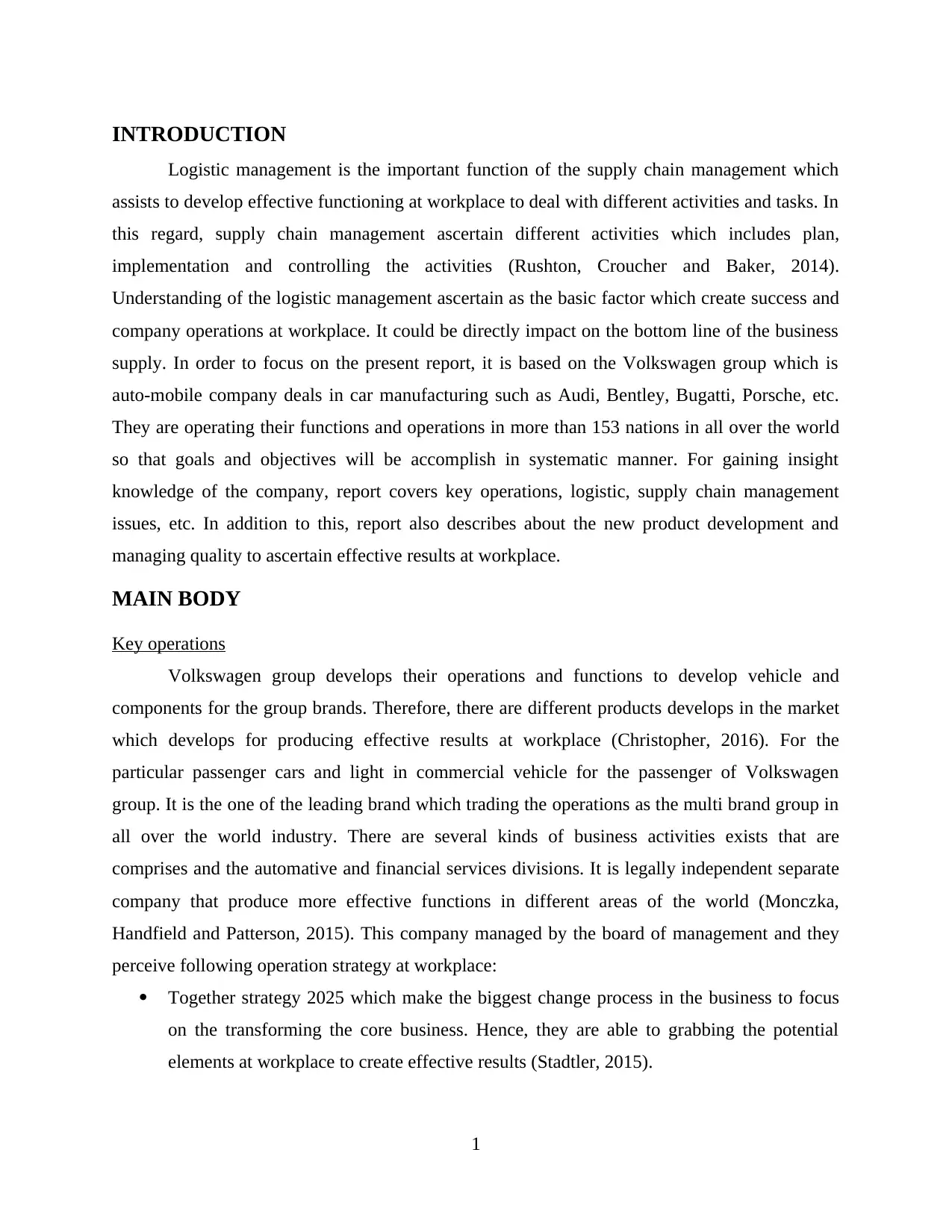
INTRODUCTION
Logistic management is the important function of the supply chain management which
assists to develop effective functioning at workplace to deal with different activities and tasks. In
this regard, supply chain management ascertain different activities which includes plan,
implementation and controlling the activities (Rushton, Croucher and Baker, 2014).
Understanding of the logistic management ascertain as the basic factor which create success and
company operations at workplace. It could be directly impact on the bottom line of the business
supply. In order to focus on the present report, it is based on the Volkswagen group which is
auto-mobile company deals in car manufacturing such as Audi, Bentley, Bugatti, Porsche, etc.
They are operating their functions and operations in more than 153 nations in all over the world
so that goals and objectives will be accomplish in systematic manner. For gaining insight
knowledge of the company, report covers key operations, logistic, supply chain management
issues, etc. In addition to this, report also describes about the new product development and
managing quality to ascertain effective results at workplace.
MAIN BODY
Key operations
Volkswagen group develops their operations and functions to develop vehicle and
components for the group brands. Therefore, there are different products develops in the market
which develops for producing effective results at workplace (Christopher, 2016). For the
particular passenger cars and light in commercial vehicle for the passenger of Volkswagen
group. It is the one of the leading brand which trading the operations as the multi brand group in
all over the world industry. There are several kinds of business activities exists that are
comprises and the automative and financial services divisions. It is legally independent separate
company that produce more effective functions in different areas of the world (Monczka,
Handfield and Patterson, 2015). This company managed by the board of management and they
perceive following operation strategy at workplace:
Together strategy 2025 which make the biggest change process in the business to focus
on the transforming the core business. Hence, they are able to grabbing the potential
elements at workplace to create effective results (Stadtler, 2015).
1
Logistic management is the important function of the supply chain management which
assists to develop effective functioning at workplace to deal with different activities and tasks. In
this regard, supply chain management ascertain different activities which includes plan,
implementation and controlling the activities (Rushton, Croucher and Baker, 2014).
Understanding of the logistic management ascertain as the basic factor which create success and
company operations at workplace. It could be directly impact on the bottom line of the business
supply. In order to focus on the present report, it is based on the Volkswagen group which is
auto-mobile company deals in car manufacturing such as Audi, Bentley, Bugatti, Porsche, etc.
They are operating their functions and operations in more than 153 nations in all over the world
so that goals and objectives will be accomplish in systematic manner. For gaining insight
knowledge of the company, report covers key operations, logistic, supply chain management
issues, etc. In addition to this, report also describes about the new product development and
managing quality to ascertain effective results at workplace.
MAIN BODY
Key operations
Volkswagen group develops their operations and functions to develop vehicle and
components for the group brands. Therefore, there are different products develops in the market
which develops for producing effective results at workplace (Christopher, 2016). For the
particular passenger cars and light in commercial vehicle for the passenger of Volkswagen
group. It is the one of the leading brand which trading the operations as the multi brand group in
all over the world industry. There are several kinds of business activities exists that are
comprises and the automative and financial services divisions. It is legally independent separate
company that produce more effective functions in different areas of the world (Monczka,
Handfield and Patterson, 2015). This company managed by the board of management and they
perceive following operation strategy at workplace:
Together strategy 2025 which make the biggest change process in the business to focus
on the transforming the core business. Hence, they are able to grabbing the potential
elements at workplace to create effective results (Stadtler, 2015).
1
Paraphrase This Document
Need a fresh take? Get an instant paraphrase of this document with our AI Paraphraser
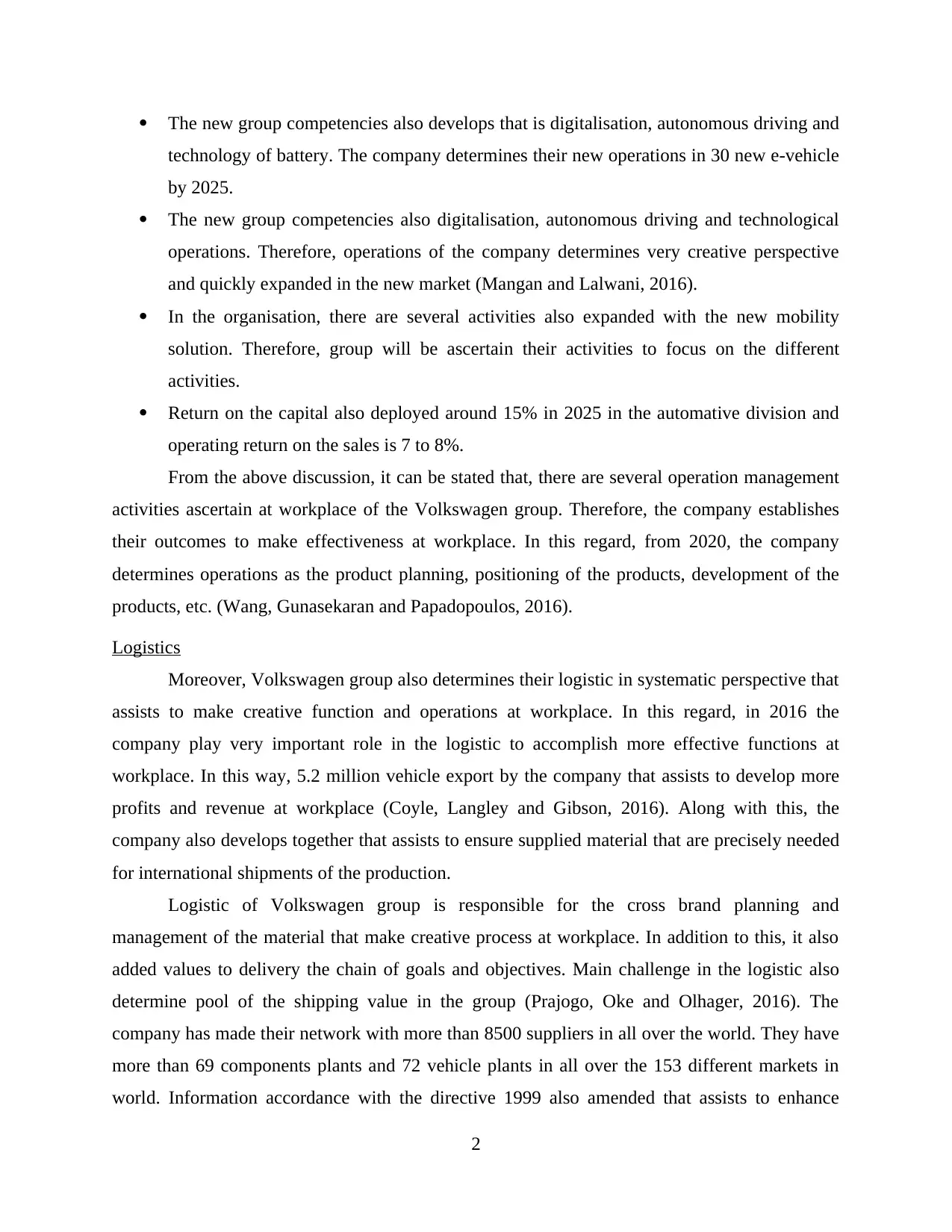
The new group competencies also develops that is digitalisation, autonomous driving and
technology of battery. The company determines their new operations in 30 new e-vehicle
by 2025.
The new group competencies also digitalisation, autonomous driving and technological
operations. Therefore, operations of the company determines very creative perspective
and quickly expanded in the new market (Mangan and Lalwani, 2016).
In the organisation, there are several activities also expanded with the new mobility
solution. Therefore, group will be ascertain their activities to focus on the different
activities.
Return on the capital also deployed around 15% in 2025 in the automative division and
operating return on the sales is 7 to 8%.
From the above discussion, it can be stated that, there are several operation management
activities ascertain at workplace of the Volkswagen group. Therefore, the company establishes
their outcomes to make effectiveness at workplace. In this regard, from 2020, the company
determines operations as the product planning, positioning of the products, development of the
products, etc. (Wang, Gunasekaran and Papadopoulos, 2016).
Logistics
Moreover, Volkswagen group also determines their logistic in systematic perspective that
assists to make creative function and operations at workplace. In this regard, in 2016 the
company play very important role in the logistic to accomplish more effective functions at
workplace. In this way, 5.2 million vehicle export by the company that assists to develop more
profits and revenue at workplace (Coyle, Langley and Gibson, 2016). Along with this, the
company also develops together that assists to ensure supplied material that are precisely needed
for international shipments of the production.
Logistic of Volkswagen group is responsible for the cross brand planning and
management of the material that make creative process at workplace. In addition to this, it also
added values to delivery the chain of goals and objectives. Main challenge in the logistic also
determine pool of the shipping value in the group (Prajogo, Oke and Olhager, 2016). The
company has made their network with more than 8500 suppliers in all over the world. They have
more than 69 components plants and 72 vehicle plants in all over the 153 different markets in
world. Information accordance with the directive 1999 also amended that assists to enhance
2
technology of battery. The company determines their new operations in 30 new e-vehicle
by 2025.
The new group competencies also digitalisation, autonomous driving and technological
operations. Therefore, operations of the company determines very creative perspective
and quickly expanded in the new market (Mangan and Lalwani, 2016).
In the organisation, there are several activities also expanded with the new mobility
solution. Therefore, group will be ascertain their activities to focus on the different
activities.
Return on the capital also deployed around 15% in 2025 in the automative division and
operating return on the sales is 7 to 8%.
From the above discussion, it can be stated that, there are several operation management
activities ascertain at workplace of the Volkswagen group. Therefore, the company establishes
their outcomes to make effectiveness at workplace. In this regard, from 2020, the company
determines operations as the product planning, positioning of the products, development of the
products, etc. (Wang, Gunasekaran and Papadopoulos, 2016).
Logistics
Moreover, Volkswagen group also determines their logistic in systematic perspective that
assists to make creative function and operations at workplace. In this regard, in 2016 the
company play very important role in the logistic to accomplish more effective functions at
workplace. In this way, 5.2 million vehicle export by the company that assists to develop more
profits and revenue at workplace (Coyle, Langley and Gibson, 2016). Along with this, the
company also develops together that assists to ensure supplied material that are precisely needed
for international shipments of the production.
Logistic of Volkswagen group is responsible for the cross brand planning and
management of the material that make creative process at workplace. In addition to this, it also
added values to delivery the chain of goals and objectives. Main challenge in the logistic also
determine pool of the shipping value in the group (Prajogo, Oke and Olhager, 2016). The
company has made their network with more than 8500 suppliers in all over the world. They have
more than 69 components plants and 72 vehicle plants in all over the 153 different markets in
world. Information accordance with the directive 1999 also amended that assists to enhance
2
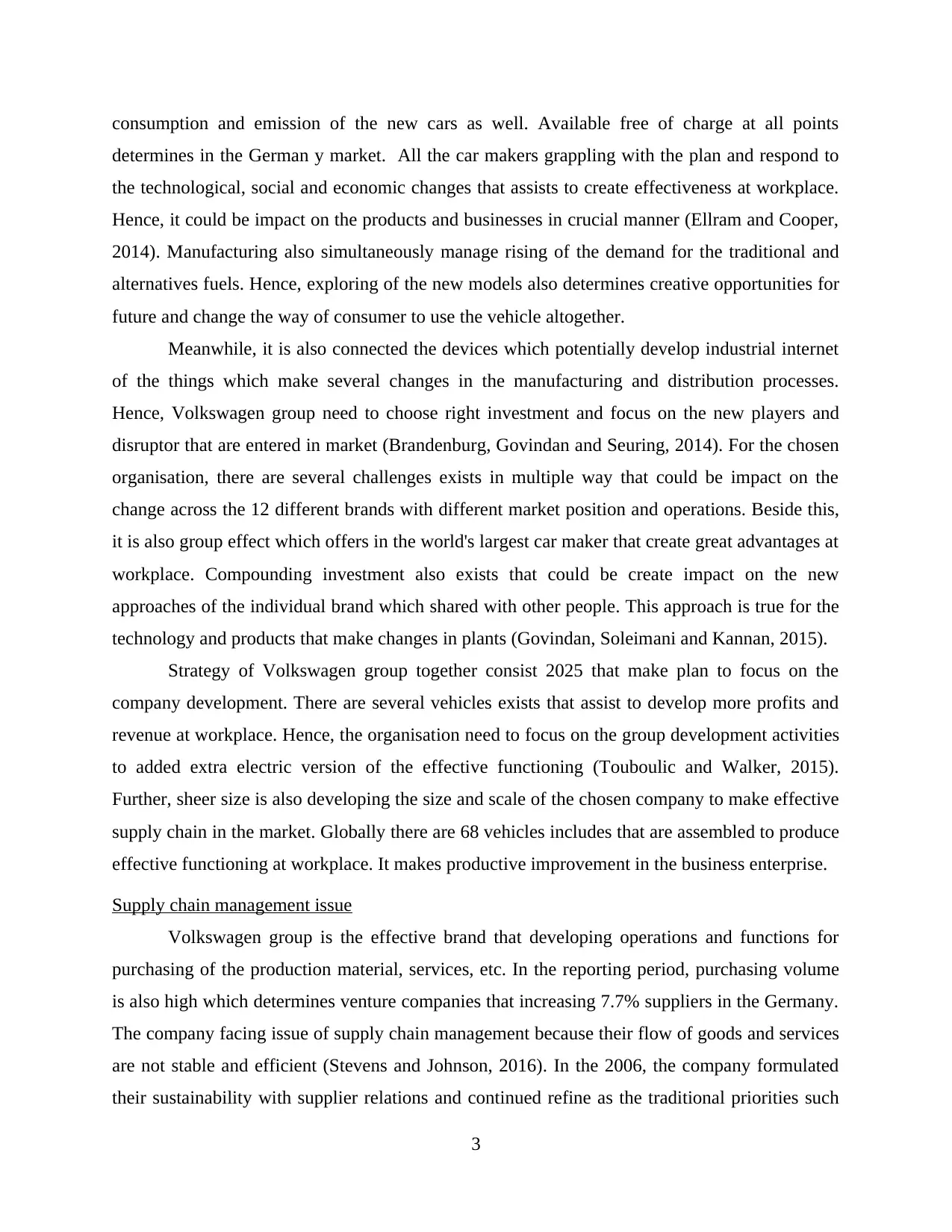
consumption and emission of the new cars as well. Available free of charge at all points
determines in the German y market. All the car makers grappling with the plan and respond to
the technological, social and economic changes that assists to create effectiveness at workplace.
Hence, it could be impact on the products and businesses in crucial manner (Ellram and Cooper,
2014). Manufacturing also simultaneously manage rising of the demand for the traditional and
alternatives fuels. Hence, exploring of the new models also determines creative opportunities for
future and change the way of consumer to use the vehicle altogether.
Meanwhile, it is also connected the devices which potentially develop industrial internet
of the things which make several changes in the manufacturing and distribution processes.
Hence, Volkswagen group need to choose right investment and focus on the new players and
disruptor that are entered in market (Brandenburg, Govindan and Seuring, 2014). For the chosen
organisation, there are several challenges exists in multiple way that could be impact on the
change across the 12 different brands with different market position and operations. Beside this,
it is also group effect which offers in the world's largest car maker that create great advantages at
workplace. Compounding investment also exists that could be create impact on the new
approaches of the individual brand which shared with other people. This approach is true for the
technology and products that make changes in plants (Govindan, Soleimani and Kannan, 2015).
Strategy of Volkswagen group together consist 2025 that make plan to focus on the
company development. There are several vehicles exists that assist to develop more profits and
revenue at workplace. Hence, the organisation need to focus on the group development activities
to added extra electric version of the effective functioning (Touboulic and Walker, 2015).
Further, sheer size is also developing the size and scale of the chosen company to make effective
supply chain in the market. Globally there are 68 vehicles includes that are assembled to produce
effective functioning at workplace. It makes productive improvement in the business enterprise.
Supply chain management issue
Volkswagen group is the effective brand that developing operations and functions for
purchasing of the production material, services, etc. In the reporting period, purchasing volume
is also high which determines venture companies that increasing 7.7% suppliers in the Germany.
The company facing issue of supply chain management because their flow of goods and services
are not stable and efficient (Stevens and Johnson, 2016). In the 2006, the company formulated
their sustainability with supplier relations and continued refine as the traditional priorities such
3
determines in the German y market. All the car makers grappling with the plan and respond to
the technological, social and economic changes that assists to create effectiveness at workplace.
Hence, it could be impact on the products and businesses in crucial manner (Ellram and Cooper,
2014). Manufacturing also simultaneously manage rising of the demand for the traditional and
alternatives fuels. Hence, exploring of the new models also determines creative opportunities for
future and change the way of consumer to use the vehicle altogether.
Meanwhile, it is also connected the devices which potentially develop industrial internet
of the things which make several changes in the manufacturing and distribution processes.
Hence, Volkswagen group need to choose right investment and focus on the new players and
disruptor that are entered in market (Brandenburg, Govindan and Seuring, 2014). For the chosen
organisation, there are several challenges exists in multiple way that could be impact on the
change across the 12 different brands with different market position and operations. Beside this,
it is also group effect which offers in the world's largest car maker that create great advantages at
workplace. Compounding investment also exists that could be create impact on the new
approaches of the individual brand which shared with other people. This approach is true for the
technology and products that make changes in plants (Govindan, Soleimani and Kannan, 2015).
Strategy of Volkswagen group together consist 2025 that make plan to focus on the
company development. There are several vehicles exists that assist to develop more profits and
revenue at workplace. Hence, the organisation need to focus on the group development activities
to added extra electric version of the effective functioning (Touboulic and Walker, 2015).
Further, sheer size is also developing the size and scale of the chosen company to make effective
supply chain in the market. Globally there are 68 vehicles includes that are assembled to produce
effective functioning at workplace. It makes productive improvement in the business enterprise.
Supply chain management issue
Volkswagen group is the effective brand that developing operations and functions for
purchasing of the production material, services, etc. In the reporting period, purchasing volume
is also high which determines venture companies that increasing 7.7% suppliers in the Germany.
The company facing issue of supply chain management because their flow of goods and services
are not stable and efficient (Stevens and Johnson, 2016). In the 2006, the company formulated
their sustainability with supplier relations and continued refine as the traditional priorities such
3
⊘ This is a preview!⊘
Do you want full access?
Subscribe today to unlock all pages.

Trusted by 1+ million students worldwide
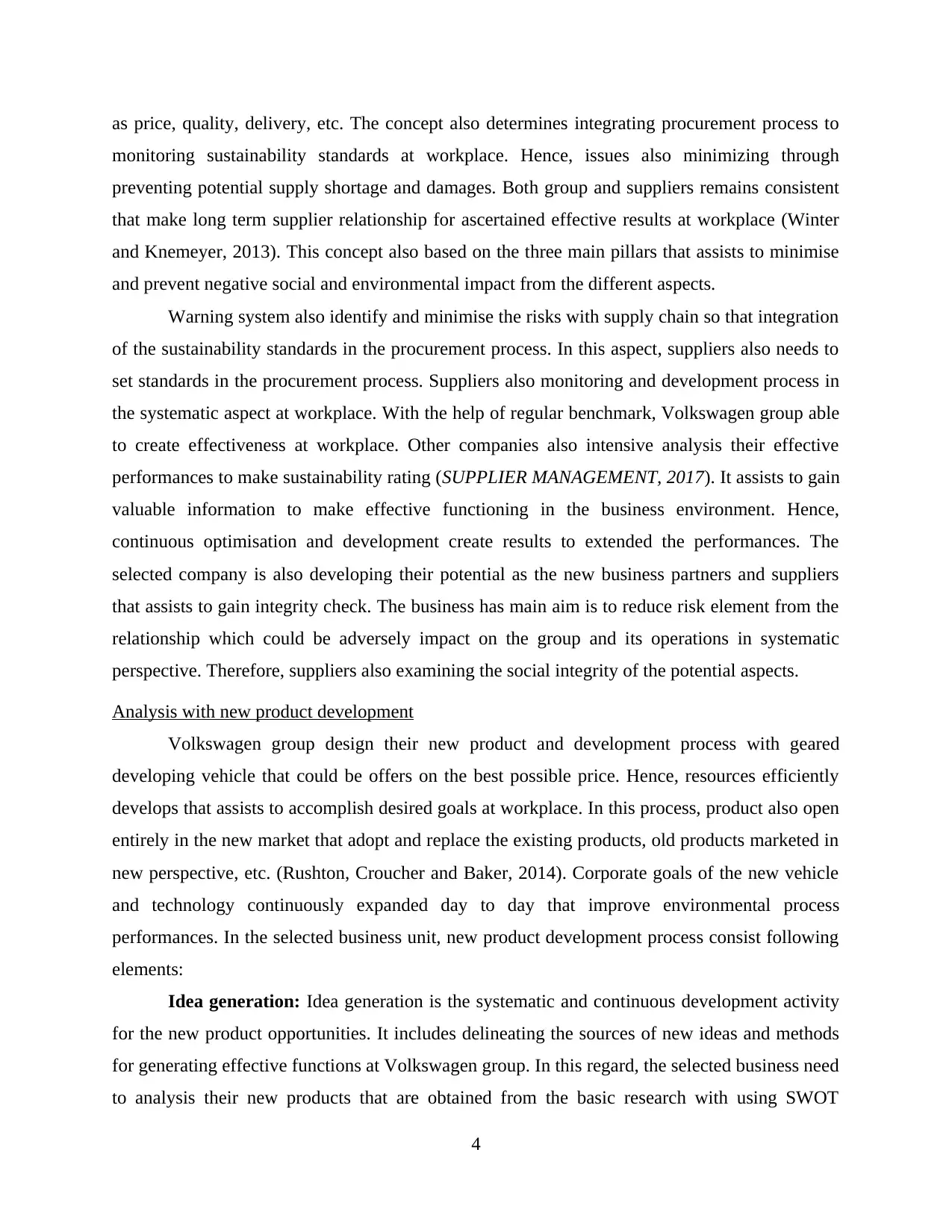
as price, quality, delivery, etc. The concept also determines integrating procurement process to
monitoring sustainability standards at workplace. Hence, issues also minimizing through
preventing potential supply shortage and damages. Both group and suppliers remains consistent
that make long term supplier relationship for ascertained effective results at workplace (Winter
and Knemeyer, 2013). This concept also based on the three main pillars that assists to minimise
and prevent negative social and environmental impact from the different aspects.
Warning system also identify and minimise the risks with supply chain so that integration
of the sustainability standards in the procurement process. In this aspect, suppliers also needs to
set standards in the procurement process. Suppliers also monitoring and development process in
the systematic aspect at workplace. With the help of regular benchmark, Volkswagen group able
to create effectiveness at workplace. Other companies also intensive analysis their effective
performances to make sustainability rating (SUPPLIER MANAGEMENT, 2017). It assists to gain
valuable information to make effective functioning in the business environment. Hence,
continuous optimisation and development create results to extended the performances. The
selected company is also developing their potential as the new business partners and suppliers
that assists to gain integrity check. The business has main aim is to reduce risk element from the
relationship which could be adversely impact on the group and its operations in systematic
perspective. Therefore, suppliers also examining the social integrity of the potential aspects.
Analysis with new product development
Volkswagen group design their new product and development process with geared
developing vehicle that could be offers on the best possible price. Hence, resources efficiently
develops that assists to accomplish desired goals at workplace. In this process, product also open
entirely in the new market that adopt and replace the existing products, old products marketed in
new perspective, etc. (Rushton, Croucher and Baker, 2014). Corporate goals of the new vehicle
and technology continuously expanded day to day that improve environmental process
performances. In the selected business unit, new product development process consist following
elements:
Idea generation: Idea generation is the systematic and continuous development activity
for the new product opportunities. It includes delineating the sources of new ideas and methods
for generating effective functions at Volkswagen group. In this regard, the selected business need
to analysis their new products that are obtained from the basic research with using SWOT
4
monitoring sustainability standards at workplace. Hence, issues also minimizing through
preventing potential supply shortage and damages. Both group and suppliers remains consistent
that make long term supplier relationship for ascertained effective results at workplace (Winter
and Knemeyer, 2013). This concept also based on the three main pillars that assists to minimise
and prevent negative social and environmental impact from the different aspects.
Warning system also identify and minimise the risks with supply chain so that integration
of the sustainability standards in the procurement process. In this aspect, suppliers also needs to
set standards in the procurement process. Suppliers also monitoring and development process in
the systematic aspect at workplace. With the help of regular benchmark, Volkswagen group able
to create effectiveness at workplace. Other companies also intensive analysis their effective
performances to make sustainability rating (SUPPLIER MANAGEMENT, 2017). It assists to gain
valuable information to make effective functioning in the business environment. Hence,
continuous optimisation and development create results to extended the performances. The
selected company is also developing their potential as the new business partners and suppliers
that assists to gain integrity check. The business has main aim is to reduce risk element from the
relationship which could be adversely impact on the group and its operations in systematic
perspective. Therefore, suppliers also examining the social integrity of the potential aspects.
Analysis with new product development
Volkswagen group design their new product and development process with geared
developing vehicle that could be offers on the best possible price. Hence, resources efficiently
develops that assists to accomplish desired goals at workplace. In this process, product also open
entirely in the new market that adopt and replace the existing products, old products marketed in
new perspective, etc. (Rushton, Croucher and Baker, 2014). Corporate goals of the new vehicle
and technology continuously expanded day to day that improve environmental process
performances. In the selected business unit, new product development process consist following
elements:
Idea generation: Idea generation is the systematic and continuous development activity
for the new product opportunities. It includes delineating the sources of new ideas and methods
for generating effective functions at Volkswagen group. In this regard, the selected business need
to analysis their new products that are obtained from the basic research with using SWOT
4
Paraphrase This Document
Need a fresh take? Get an instant paraphrase of this document with our AI Paraphraser
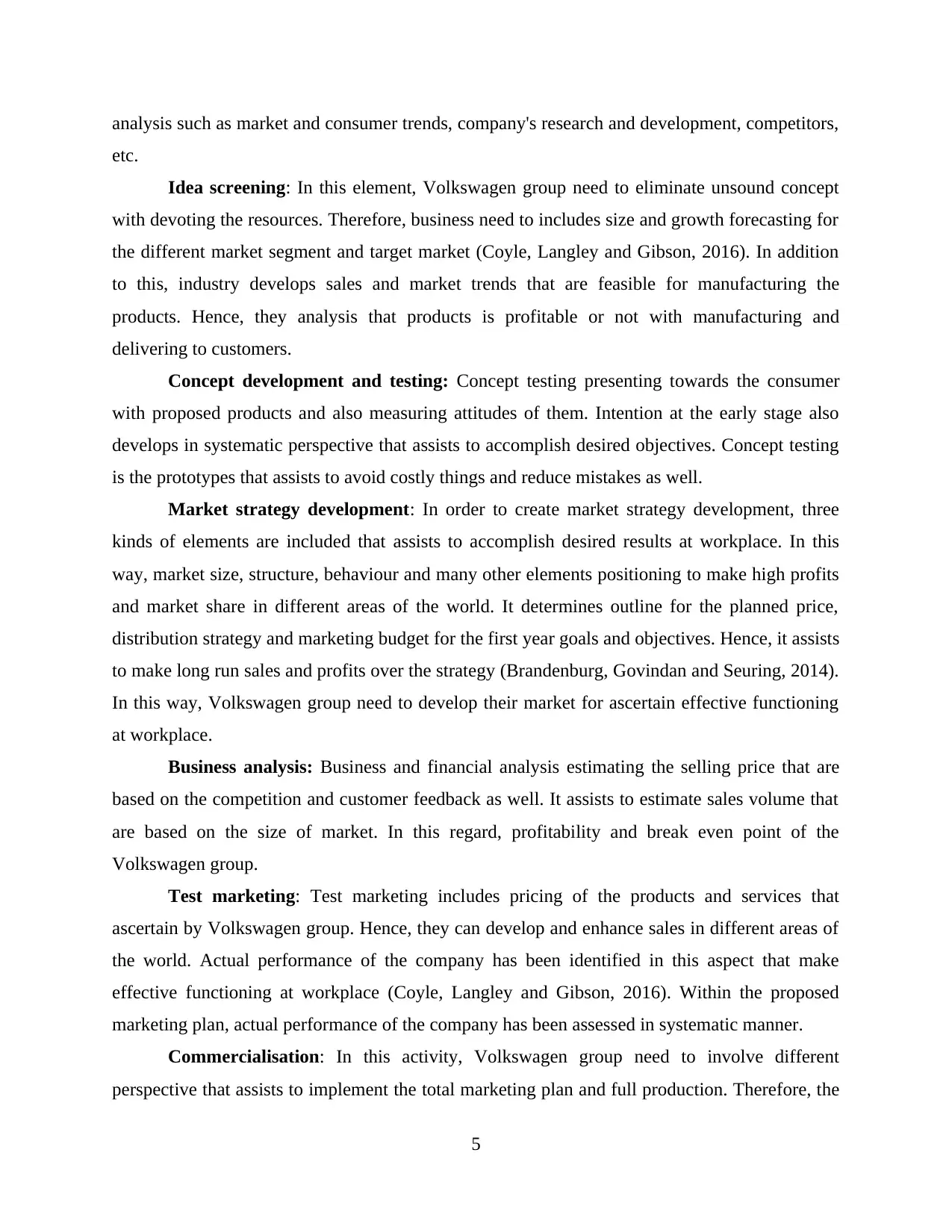
analysis such as market and consumer trends, company's research and development, competitors,
etc.
Idea screening: In this element, Volkswagen group need to eliminate unsound concept
with devoting the resources. Therefore, business need to includes size and growth forecasting for
the different market segment and target market (Coyle, Langley and Gibson, 2016). In addition
to this, industry develops sales and market trends that are feasible for manufacturing the
products. Hence, they analysis that products is profitable or not with manufacturing and
delivering to customers.
Concept development and testing: Concept testing presenting towards the consumer
with proposed products and also measuring attitudes of them. Intention at the early stage also
develops in systematic perspective that assists to accomplish desired objectives. Concept testing
is the prototypes that assists to avoid costly things and reduce mistakes as well.
Market strategy development: In order to create market strategy development, three
kinds of elements are included that assists to accomplish desired results at workplace. In this
way, market size, structure, behaviour and many other elements positioning to make high profits
and market share in different areas of the world. It determines outline for the planned price,
distribution strategy and marketing budget for the first year goals and objectives. Hence, it assists
to make long run sales and profits over the strategy (Brandenburg, Govindan and Seuring, 2014).
In this way, Volkswagen group need to develop their market for ascertain effective functioning
at workplace.
Business analysis: Business and financial analysis estimating the selling price that are
based on the competition and customer feedback as well. It assists to estimate sales volume that
are based on the size of market. In this regard, profitability and break even point of the
Volkswagen group.
Test marketing: Test marketing includes pricing of the products and services that
ascertain by Volkswagen group. Hence, they can develop and enhance sales in different areas of
the world. Actual performance of the company has been identified in this aspect that make
effective functioning at workplace (Coyle, Langley and Gibson, 2016). Within the proposed
marketing plan, actual performance of the company has been assessed in systematic manner.
Commercialisation: In this activity, Volkswagen group need to involve different
perspective that assists to implement the total marketing plan and full production. Therefore, the
5
etc.
Idea screening: In this element, Volkswagen group need to eliminate unsound concept
with devoting the resources. Therefore, business need to includes size and growth forecasting for
the different market segment and target market (Coyle, Langley and Gibson, 2016). In addition
to this, industry develops sales and market trends that are feasible for manufacturing the
products. Hence, they analysis that products is profitable or not with manufacturing and
delivering to customers.
Concept development and testing: Concept testing presenting towards the consumer
with proposed products and also measuring attitudes of them. Intention at the early stage also
develops in systematic perspective that assists to accomplish desired objectives. Concept testing
is the prototypes that assists to avoid costly things and reduce mistakes as well.
Market strategy development: In order to create market strategy development, three
kinds of elements are included that assists to accomplish desired results at workplace. In this
way, market size, structure, behaviour and many other elements positioning to make high profits
and market share in different areas of the world. It determines outline for the planned price,
distribution strategy and marketing budget for the first year goals and objectives. Hence, it assists
to make long run sales and profits over the strategy (Brandenburg, Govindan and Seuring, 2014).
In this way, Volkswagen group need to develop their market for ascertain effective functioning
at workplace.
Business analysis: Business and financial analysis estimating the selling price that are
based on the competition and customer feedback as well. It assists to estimate sales volume that
are based on the size of market. In this regard, profitability and break even point of the
Volkswagen group.
Test marketing: Test marketing includes pricing of the products and services that
ascertain by Volkswagen group. Hence, they can develop and enhance sales in different areas of
the world. Actual performance of the company has been identified in this aspect that make
effective functioning at workplace (Coyle, Langley and Gibson, 2016). Within the proposed
marketing plan, actual performance of the company has been assessed in systematic manner.
Commercialisation: In this activity, Volkswagen group need to involve different
perspective that assists to implement the total marketing plan and full production. Therefore, the
5
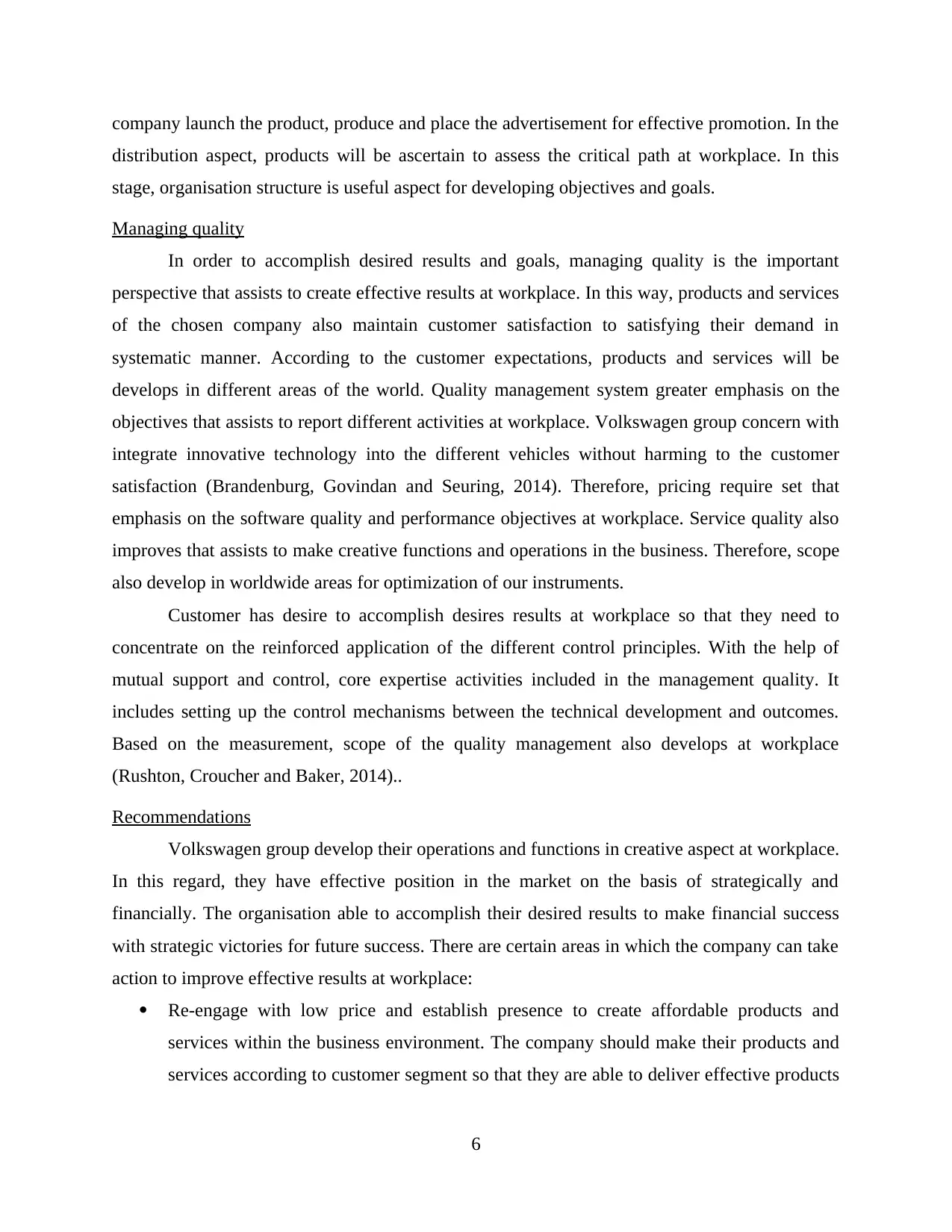
company launch the product, produce and place the advertisement for effective promotion. In the
distribution aspect, products will be ascertain to assess the critical path at workplace. In this
stage, organisation structure is useful aspect for developing objectives and goals.
Managing quality
In order to accomplish desired results and goals, managing quality is the important
perspective that assists to create effective results at workplace. In this way, products and services
of the chosen company also maintain customer satisfaction to satisfying their demand in
systematic manner. According to the customer expectations, products and services will be
develops in different areas of the world. Quality management system greater emphasis on the
objectives that assists to report different activities at workplace. Volkswagen group concern with
integrate innovative technology into the different vehicles without harming to the customer
satisfaction (Brandenburg, Govindan and Seuring, 2014). Therefore, pricing require set that
emphasis on the software quality and performance objectives at workplace. Service quality also
improves that assists to make creative functions and operations in the business. Therefore, scope
also develop in worldwide areas for optimization of our instruments.
Customer has desire to accomplish desires results at workplace so that they need to
concentrate on the reinforced application of the different control principles. With the help of
mutual support and control, core expertise activities included in the management quality. It
includes setting up the control mechanisms between the technical development and outcomes.
Based on the measurement, scope of the quality management also develops at workplace
(Rushton, Croucher and Baker, 2014)..
Recommendations
Volkswagen group develop their operations and functions in creative aspect at workplace.
In this regard, they have effective position in the market on the basis of strategically and
financially. The organisation able to accomplish their desired results to make financial success
with strategic victories for future success. There are certain areas in which the company can take
action to improve effective results at workplace:
Re-engage with low price and establish presence to create affordable products and
services within the business environment. The company should make their products and
services according to customer segment so that they are able to deliver effective products
6
distribution aspect, products will be ascertain to assess the critical path at workplace. In this
stage, organisation structure is useful aspect for developing objectives and goals.
Managing quality
In order to accomplish desired results and goals, managing quality is the important
perspective that assists to create effective results at workplace. In this way, products and services
of the chosen company also maintain customer satisfaction to satisfying their demand in
systematic manner. According to the customer expectations, products and services will be
develops in different areas of the world. Quality management system greater emphasis on the
objectives that assists to report different activities at workplace. Volkswagen group concern with
integrate innovative technology into the different vehicles without harming to the customer
satisfaction (Brandenburg, Govindan and Seuring, 2014). Therefore, pricing require set that
emphasis on the software quality and performance objectives at workplace. Service quality also
improves that assists to make creative functions and operations in the business. Therefore, scope
also develop in worldwide areas for optimization of our instruments.
Customer has desire to accomplish desires results at workplace so that they need to
concentrate on the reinforced application of the different control principles. With the help of
mutual support and control, core expertise activities included in the management quality. It
includes setting up the control mechanisms between the technical development and outcomes.
Based on the measurement, scope of the quality management also develops at workplace
(Rushton, Croucher and Baker, 2014)..
Recommendations
Volkswagen group develop their operations and functions in creative aspect at workplace.
In this regard, they have effective position in the market on the basis of strategically and
financially. The organisation able to accomplish their desired results to make financial success
with strategic victories for future success. There are certain areas in which the company can take
action to improve effective results at workplace:
Re-engage with low price and establish presence to create affordable products and
services within the business environment. The company should make their products and
services according to customer segment so that they are able to deliver effective products
6
⊘ This is a preview!⊘
Do you want full access?
Subscribe today to unlock all pages.

Trusted by 1+ million students worldwide
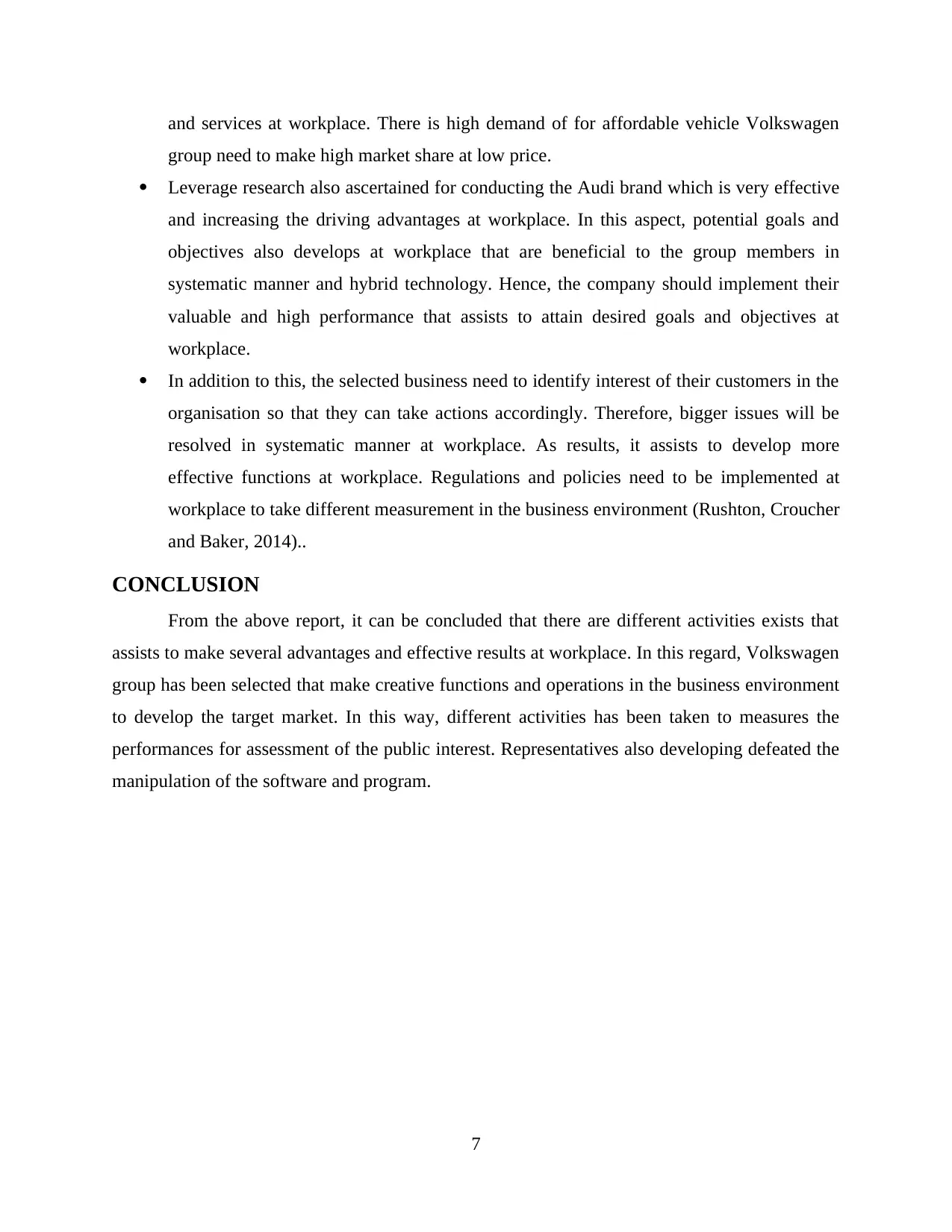
and services at workplace. There is high demand of for affordable vehicle Volkswagen
group need to make high market share at low price.
Leverage research also ascertained for conducting the Audi brand which is very effective
and increasing the driving advantages at workplace. In this aspect, potential goals and
objectives also develops at workplace that are beneficial to the group members in
systematic manner and hybrid technology. Hence, the company should implement their
valuable and high performance that assists to attain desired goals and objectives at
workplace.
In addition to this, the selected business need to identify interest of their customers in the
organisation so that they can take actions accordingly. Therefore, bigger issues will be
resolved in systematic manner at workplace. As results, it assists to develop more
effective functions at workplace. Regulations and policies need to be implemented at
workplace to take different measurement in the business environment (Rushton, Croucher
and Baker, 2014)..
CONCLUSION
From the above report, it can be concluded that there are different activities exists that
assists to make several advantages and effective results at workplace. In this regard, Volkswagen
group has been selected that make creative functions and operations in the business environment
to develop the target market. In this way, different activities has been taken to measures the
performances for assessment of the public interest. Representatives also developing defeated the
manipulation of the software and program.
7
group need to make high market share at low price.
Leverage research also ascertained for conducting the Audi brand which is very effective
and increasing the driving advantages at workplace. In this aspect, potential goals and
objectives also develops at workplace that are beneficial to the group members in
systematic manner and hybrid technology. Hence, the company should implement their
valuable and high performance that assists to attain desired goals and objectives at
workplace.
In addition to this, the selected business need to identify interest of their customers in the
organisation so that they can take actions accordingly. Therefore, bigger issues will be
resolved in systematic manner at workplace. As results, it assists to develop more
effective functions at workplace. Regulations and policies need to be implemented at
workplace to take different measurement in the business environment (Rushton, Croucher
and Baker, 2014)..
CONCLUSION
From the above report, it can be concluded that there are different activities exists that
assists to make several advantages and effective results at workplace. In this regard, Volkswagen
group has been selected that make creative functions and operations in the business environment
to develop the target market. In this way, different activities has been taken to measures the
performances for assessment of the public interest. Representatives also developing defeated the
manipulation of the software and program.
7
Paraphrase This Document
Need a fresh take? Get an instant paraphrase of this document with our AI Paraphraser
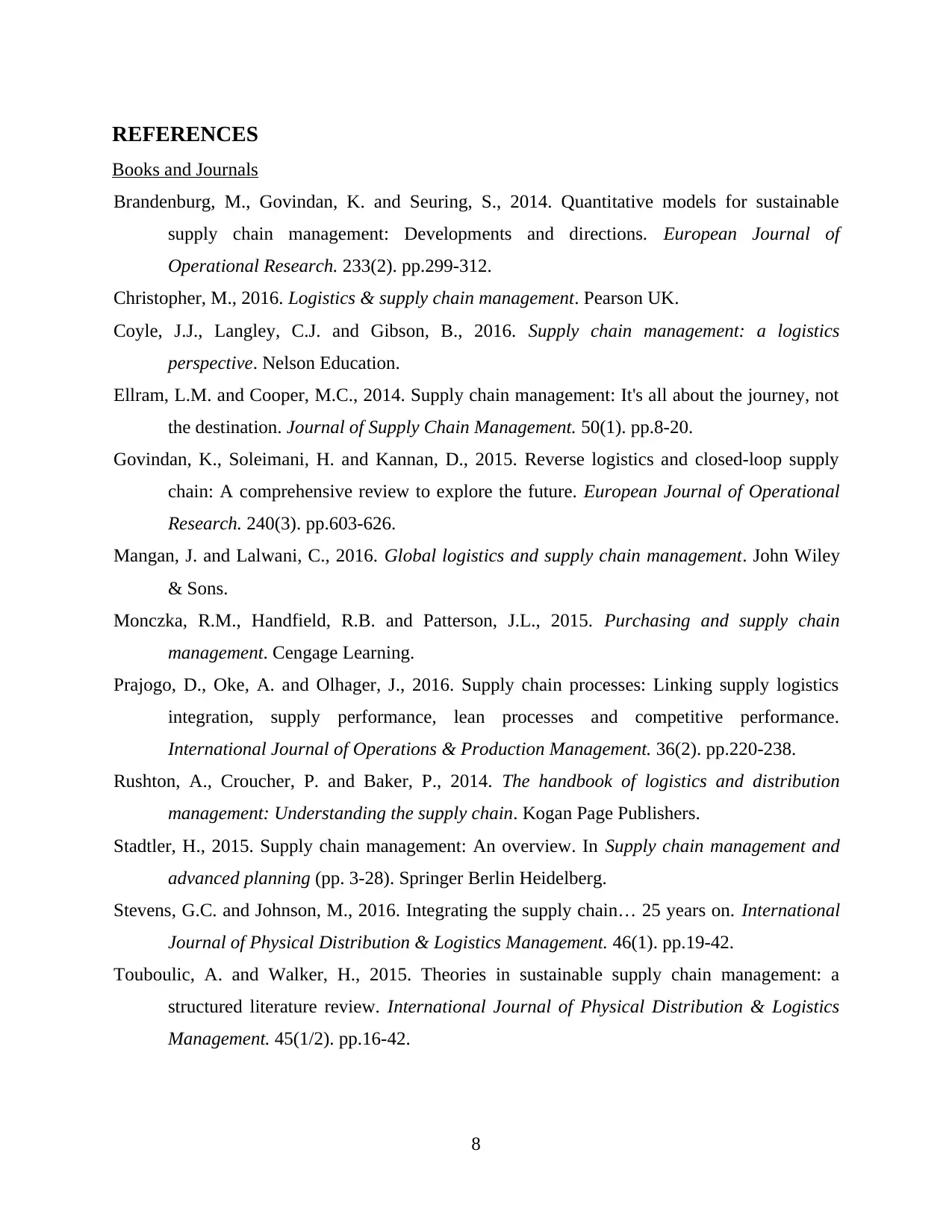
REFERENCES
Books and Journals
Brandenburg, M., Govindan, K. and Seuring, S., 2014. Quantitative models for sustainable
supply chain management: Developments and directions. European Journal of
Operational Research. 233(2). pp.299-312.
Christopher, M., 2016. Logistics & supply chain management. Pearson UK.
Coyle, J.J., Langley, C.J. and Gibson, B., 2016. Supply chain management: a logistics
perspective. Nelson Education.
Ellram, L.M. and Cooper, M.C., 2014. Supply chain management: It's all about the journey, not
the destination. Journal of Supply Chain Management. 50(1). pp.8-20.
Govindan, K., Soleimani, H. and Kannan, D., 2015. Reverse logistics and closed-loop supply
chain: A comprehensive review to explore the future. European Journal of Operational
Research. 240(3). pp.603-626.
Mangan, J. and Lalwani, C., 2016. Global logistics and supply chain management. John Wiley
& Sons.
Monczka, R.M., Handfield, R.B. and Patterson, J.L., 2015. Purchasing and supply chain
management. Cengage Learning.
Prajogo, D., Oke, A. and Olhager, J., 2016. Supply chain processes: Linking supply logistics
integration, supply performance, lean processes and competitive performance.
International Journal of Operations & Production Management. 36(2). pp.220-238.
Rushton, A., Croucher, P. and Baker, P., 2014. The handbook of logistics and distribution
management: Understanding the supply chain. Kogan Page Publishers.
Stadtler, H., 2015. Supply chain management: An overview. In Supply chain management and
advanced planning (pp. 3-28). Springer Berlin Heidelberg.
Stevens, G.C. and Johnson, M., 2016. Integrating the supply chain… 25 years on. International
Journal of Physical Distribution & Logistics Management. 46(1). pp.19-42.
Touboulic, A. and Walker, H., 2015. Theories in sustainable supply chain management: a
structured literature review. International Journal of Physical Distribution & Logistics
Management. 45(1/2). pp.16-42.
8
Books and Journals
Brandenburg, M., Govindan, K. and Seuring, S., 2014. Quantitative models for sustainable
supply chain management: Developments and directions. European Journal of
Operational Research. 233(2). pp.299-312.
Christopher, M., 2016. Logistics & supply chain management. Pearson UK.
Coyle, J.J., Langley, C.J. and Gibson, B., 2016. Supply chain management: a logistics
perspective. Nelson Education.
Ellram, L.M. and Cooper, M.C., 2014. Supply chain management: It's all about the journey, not
the destination. Journal of Supply Chain Management. 50(1). pp.8-20.
Govindan, K., Soleimani, H. and Kannan, D., 2015. Reverse logistics and closed-loop supply
chain: A comprehensive review to explore the future. European Journal of Operational
Research. 240(3). pp.603-626.
Mangan, J. and Lalwani, C., 2016. Global logistics and supply chain management. John Wiley
& Sons.
Monczka, R.M., Handfield, R.B. and Patterson, J.L., 2015. Purchasing and supply chain
management. Cengage Learning.
Prajogo, D., Oke, A. and Olhager, J., 2016. Supply chain processes: Linking supply logistics
integration, supply performance, lean processes and competitive performance.
International Journal of Operations & Production Management. 36(2). pp.220-238.
Rushton, A., Croucher, P. and Baker, P., 2014. The handbook of logistics and distribution
management: Understanding the supply chain. Kogan Page Publishers.
Stadtler, H., 2015. Supply chain management: An overview. In Supply chain management and
advanced planning (pp. 3-28). Springer Berlin Heidelberg.
Stevens, G.C. and Johnson, M., 2016. Integrating the supply chain… 25 years on. International
Journal of Physical Distribution & Logistics Management. 46(1). pp.19-42.
Touboulic, A. and Walker, H., 2015. Theories in sustainable supply chain management: a
structured literature review. International Journal of Physical Distribution & Logistics
Management. 45(1/2). pp.16-42.
8
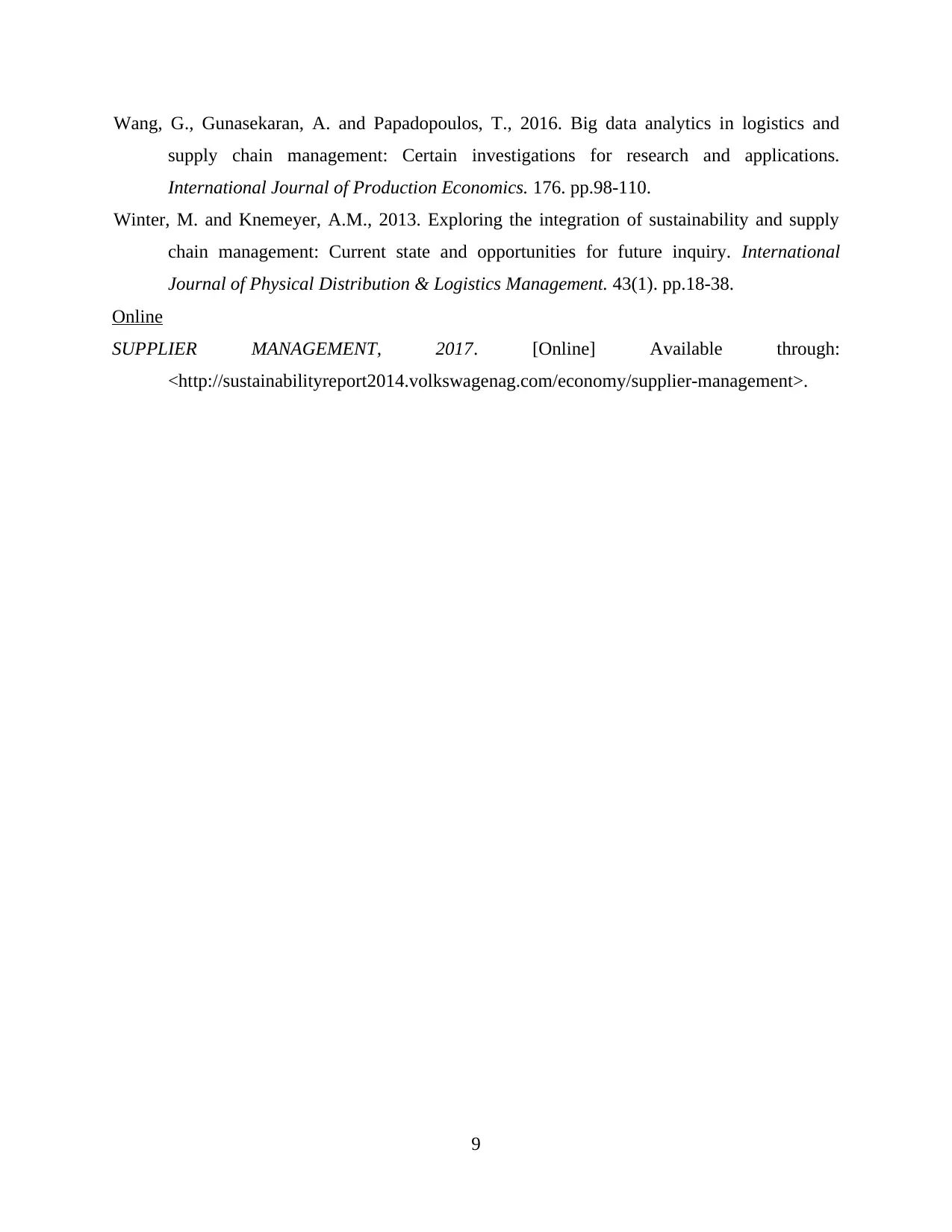
Wang, G., Gunasekaran, A. and Papadopoulos, T., 2016. Big data analytics in logistics and
supply chain management: Certain investigations for research and applications.
International Journal of Production Economics. 176. pp.98-110.
Winter, M. and Knemeyer, A.M., 2013. Exploring the integration of sustainability and supply
chain management: Current state and opportunities for future inquiry. International
Journal of Physical Distribution & Logistics Management. 43(1). pp.18-38.
Online
SUPPLIER MANAGEMENT, 2017. [Online] Available through:
<http://sustainabilityreport2014.volkswagenag.com/economy/supplier-management>.
9
supply chain management: Certain investigations for research and applications.
International Journal of Production Economics. 176. pp.98-110.
Winter, M. and Knemeyer, A.M., 2013. Exploring the integration of sustainability and supply
chain management: Current state and opportunities for future inquiry. International
Journal of Physical Distribution & Logistics Management. 43(1). pp.18-38.
Online
SUPPLIER MANAGEMENT, 2017. [Online] Available through:
<http://sustainabilityreport2014.volkswagenag.com/economy/supplier-management>.
9
⊘ This is a preview!⊘
Do you want full access?
Subscribe today to unlock all pages.

Trusted by 1+ million students worldwide
1 out of 12
Related Documents
Your All-in-One AI-Powered Toolkit for Academic Success.
+13062052269
info@desklib.com
Available 24*7 on WhatsApp / Email
![[object Object]](/_next/static/media/star-bottom.7253800d.svg)
Unlock your academic potential
Copyright © 2020–2025 A2Z Services. All Rights Reserved. Developed and managed by ZUCOL.





